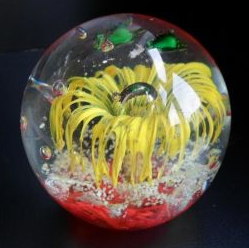What is a Paperweight?
by Steve Richardson, PCA Outreach Director
If you have been collecting for even a short time, you have probably heard that question a few times. If you haven’t heard it out loud, you’ve at least run across people who give you a blank stare of polite puzzlement when you tell them what you collect in your spare time.
 The confusion starts with the word “paperweight” itself. Even the earliest modern paperweights were designed more as decorative objects than as utilitarian tools to keep papers from blowing off your desk. It might have been more helpful to refer to them as glass sculptures or miniature worlds or – as some artists today call them – orbs.
The confusion starts with the word “paperweight” itself. Even the earliest modern paperweights were designed more as decorative objects than as utilitarian tools to keep papers from blowing off your desk. It might have been more helpful to refer to them as glass sculptures or miniature worlds or – as some artists today call them – orbs.
 The more fundamental problem, though, is that many things have been called paperweights. There are also many small objects – think snow globes or pet rocks – that fit the broad definition of being mildly artistic and commonly found on desks. I find it difficult to explain why those don’t belong in my paperweight collection, at least without sounding a bit snobbish.
The more fundamental problem, though, is that many things have been called paperweights. There are also many small objects – think snow globes or pet rocks – that fit the broad definition of being mildly artistic and commonly found on desks. I find it difficult to explain why those don’t belong in my paperweight collection, at least without sounding a bit snobbish.


Part of the problem is that we each have personal feelings about what is “artistic”. We build a mental hierarchy that includes everything from the Mona Lisa to our grandchildren’s refrigerator art, and we draw a line that puts pet rocks on one side and real paperweights on the other. Another part is that many objects that PCA members collect are, frankly, expensive. They are items that people buy with discretionary income. If you have collected even a few costly paperweights, you may appear to be in different circumstances than people who can only afford snow globes. This is very delicate territory, particularly when we are debating about where mass-marketed Chinese weights and some Murano weights fall in the spectrum.

 These days, the definition of “paperweight” is becoming even more fluid than it once was, as artists are experimenting with unconventional shapes and different styles of decoration. Paperweights are no longer just spheroidal glass objects, but may be cubes, cylinders, or more organic forms. They may have flowers, lizards, or other elements attached to them. They may be carved, engraved, or include intricately painted scenes. They may have metallic electroplated decorations or may include mineral matter or even funereal ashes. Artists may also borrow techniques from marble makers and jewelry designers, thus blurring lines that may have once been sharper between paperweights and other art forms.
These days, the definition of “paperweight” is becoming even more fluid than it once was, as artists are experimenting with unconventional shapes and different styles of decoration. Paperweights are no longer just spheroidal glass objects, but may be cubes, cylinders, or more organic forms. They may have flowers, lizards, or other elements attached to them. They may be carved, engraved, or include intricately painted scenes. They may have metallic electroplated decorations or may include mineral matter or even funereal ashes. Artists may also borrow techniques from marble makers and jewelry designers, thus blurring lines that may have once been sharper between paperweights and other art forms.
All of this can make the innocent question “What is a paperweight?” difficult to answer. If you’ve attended conventions or paperweight fests in recent years, you can probably recall a few talks in which speakers have trod into uncomfortable territory by trying to address it too restrictively. Personally, I think the best response is Show and Tell. There are marvelous collections out there. You may own one yourself but, if not, you can find photos on line and – if you are lucky – can suggest a visit to a nearby museum or dealer that can show a variety of paperweights. If the person you’re talking with displays a spark of interest, he’ll arrive at his own definition and find a favorite niche somewhere in the broad range of things we call paperweights. And you will have invited a new enthusiast into the fold.


Thank you for your perspective and for sharing your experience!
I've had this discussion a few years ago on Paperweight Heaven. What is a paperweight? To my big surprise mr. William Manson snr., a glass artist who is plentyfull presented in my collection, had a totaly different opinion then me, and I felt a bit like the young pupil in conflict with the old master. The old master teached me that it is a personal thing, if someone sees a paperweight in his object, it's a paperweight! I must admit that I couldn't deal with this opionion. To me a paperweight is more then that; it must be a collectors item, it is part of a world described in many books about paperweights. I always believed there is a difference between a paperweight and 'other' glas-art. Which hampers the discussion one more time; is a paperweight made of glas? Of course I didn't have the ripeness to look behind the fence. Now I realise mr. Williams was right. It is not the object itself that makes a paperweight out of it! It is the enthusiasm of the observer!